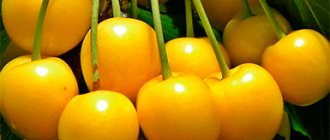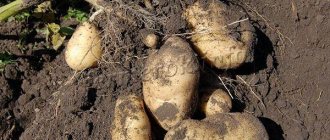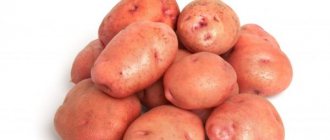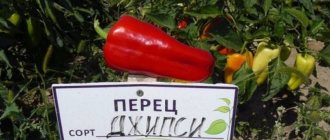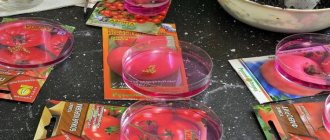Description of carrot variety Losinoostrovskaya
Losinoostrovskaya is a table carrot variety characterized by large orange-colored roots with juicy and sweet pulp.
Origin
The variety was bred in the middle of the 20th century. in the Federal State Budgetary Institution “Federal Scientific Center for Vegetable Growing” as a result of crossing carrots Amsterdam, Tushon, Nantes-4 and other varieties with cylindrical root crops.
The variety was included in the State Register of Russia in 1964.
Chemical composition, trace elements and vitamins, beneficial properties
100 g of carrots contain:
- sugar – 9%;
- beta-carotene – about 28 mg;
- ascorbic acid – 5 mg;
- vitamin PP – 1 mg;
- B1 – 0.06 mg;
- B2 – 0.07 mg;
- B5 – 0.3 mg;
- B6 – 0.1 mg;
- calcium – 27 mg;
- magnesium – 38 mg;
- sodium – 21 mg;
- iron – 0.7 mg;
- zinc – 0.4 mg.
Regular consumption of vegetables helps normalize metabolism, increase immunity, and ensure normal function of the visual organs. Carrot juice is useful for anemia, people with hypo- and avitaminosis A, cholelithiasis, and metabolic polyarthritis.
Features of application
Root vegetables are suitable for freezing, canning, making juices, purees and desserts. They are consumed fresh, added to stews and pureed soups, and used as a snack (for example, Korean carrots).
Ripening time and yield
This is a mid-season variety - the crop is ready for harvest 80-118 days after emergence .
The average yield is 5.4-7.7 kg/m².
Disease resistance
The variety is resistant to most diseases characteristic of the crop , but it can be affected by phomosis, white rot, bacteriosis and rhizoctonia.
Characteristics, description of appearance, taste
Losinoostrovskaya has straight or slightly spreading tops 35-40 cm high . The rosette consists of 13, less often 11, rich green leaves of a diamond-shaped or triangular shape with a strongly indented outline.
The root crops are cylindrical in shape with a rounded or pointed end, reaching 12.5-16 cm in length, 3.2-4.2 cm in diameter and weighing 75-165 g. The surface is smooth, with small eyes and thin lateral root processes located on it.
The peel is thin, with a slight glossy sheen, the flesh is orange, the core is pronounced, round in cross-section or resembles a polyhedron.
The pulp is juicy and sweet , without bitterness.
Growing regions and climate requirements
The variety is included in the State Register with a recommendation for cultivation in the North-Western, Central, Volga-Vyatka, Central Black Earth, North Caucasus, Middle Volga, West Siberian and Far Eastern regions.
Carrot Losinoostrovskaya 13. Article
Characteristic
The carrot variety Losinoostrovskaya 13 is grown in open areas. The variety was made popular by:
- high yield - 8 kg per 1 m²;
- resistance to low temperatures;
- good keeping quality.
The vegetable is widely used in cooking for making juices and purees. The growing season is 78–110 days. Losinoostrovskaya carrots are classified as mid-season crops.
Description of fruits
The leaves are green in color and have a semi-erect rosette. Most of the root crops are in the soil, occasionally protruding above the surface (up to 4 cm). Carrot fruits of the Losinoostrovskaya 13 variety are cylindrical in shape. The length of a mature root crop is 18 cm, weight - from 160 to 200 g.
Advantages and disadvantages of the variety
The main advantages of the variety:
- juicy and sweet pulp;
- good commercial quality;
- delicate core structure;
- high carotene content;
- frost resistance;
- immunity to many common diseases and pests;
- lack of tendency to cracking and discoloration;
- abundant yield;
- possibility of universal use;
- long-term storage and good keeping quality.
No deficiencies were found in Losinoostrovskaya.
Difference from other varieties
In addition to the increased carotene content compared to most carrot varieties, the peculiarity of Losinoostrovskaya is the absence of a green circle at the base of the root crop - where it grows together with the tops. This is explained by the fact that throughout the growing season the root crop is completely immersed in the soil.
Rules and terms of landing
Smooth beds of carrots with lacy leaves are a real decoration for unsightly areas, even for gardeners with no experience. Carrots are considered the most revered root vegetable in gardens today. Only those who adhere to the growing rules can enjoy a good harvest of beautiful, even fruits.
One of the planting rules is the timing of sowing carrots. They are directly dependent on the goals of gardeners and on the characteristics of the variety itself. Losinoostrovskaya carrots from winter sowing are used for summer sales; they are not suitable for long-term storage.
To get early production from carrots sown in spring, sowing should be done when the soil warms up to +8 degrees. Try to do this early to use up all the moisture in the soil. In the southern regions it will be the end of March or the first days of April. The final period for sowing carrot seeds in the south of the country is July 20.
Features of planting and growing
The variety is unpretentious in care, but to obtain a high-quality harvest, it is necessary to choose the right planting site and comply with the basic agrotechnical requirements of the crop.
Preparing for landing
Before planting, remove any remaining essential oils from the seeds .
To do this, they are poured into a gauze bag, lowered into a container with warm (+44...+48°C) water, rinsed 2-3 times and left until the water reaches room temperature. After this, the seeds are transferred to a sieve, washed with running water and laid out on a napkin to dry. Then the planting material is placed between two layers of linen cloth soaked in a solution of a growth stimulator (Epin, Kornevin), left for a day, then rinsed with running water and left for 6 hours in a dark, cool place for hardening.
After 6 hours, the seeds are laid out on the same damp cloth, placed in a wide, shallow container, covered with film and put in a warm place. The fabric is periodically moistened and the film is removed so that the seeds receive oxygen.
In the fall, the area is cleared of plant debris, dug up with a shovel and fertilized with compost or humus (1 bucket per 1 m²).
In spring, the soil is dug up again, leveled, abundantly watered with warm (+50...+60°C) water and covered with garden film to create a greenhouse effect and prevent drying out.
Soil requirements
The variety grows and develops in light, nutritious soil with good moisture permeability , aeration and a neutral acidity level (pH 6.0-7.0). The best option is loamy, ash, sandy soils and a substrate consisting of peat, ash, sand and pine needles.
Reference. Add sand to heavy soil at the rate of 12 kg per 1 m², and add chalk, lime or cement dust to acidic soil.
Predecessors
Carrots grow well after potatoes, tomatoes, lettuce, green manure, onions and garlic.
Dates, scheme and rules of planting
Seeds are sown before winter (in October) or in spring (late March - early April) . The main thing is that the soil is warmed to at least +5°C.
Boarding order:
- Prepare beds in the selected area, located at a distance of 30-40 cm from each other.
- Every 30 cm, make grooves in them with a depth of 1 cm (for loam) or 2 cm (for sandy loam).
- Place the seeds in them, keeping a distance of 4.5-5 cm between the grains.
- Cover the plantings with soil.
For ease of sowing, seeds are glued to thin paper tape in advance .
Features of cultivation
The growth and development of vegetables depends on the composition of the soil and climatic conditions . If sowing was carried out at a temperature of +8...+9°C, seedlings will appear in 26-34 days, at +25°C - after 7-10 days.
Active development of root crops begins at a temperature of +15...+19°C , optimal indicators for green growth are +20...+24°C.
Reference. In hot weather, at soil temperatures above +25°C, root crops slow down in development.
Losinoostrovskaya does not have any special care requirements, but there are some peculiarities.
Watering mode
Plants are watered every 3 days at the rate of 3 liters of water per 1 m² . In the absence of natural precipitation, watering is carried out every other day, and the volume of water is increased to 5 liters per 1 m².
Reference. Watering is stopped 2-3 weeks before harvest.
Thinning and weed control
Thin out densely growing seedlings due to frequent sowing of seeds .
Otherwise, the root vegetables will become intertwined and deformed. For the first time, the beds are thinned after the sprouts emerge. Water the soil and remove weak shoots by vertically pulling out the shoots. As a result, strong seedlings remain on the beds, at a distance of 3.5-4 cm from each other. They are watered with warm (+30…+35°C) water at the rate of 3-3.5 liters per 1 m².
The soil between the rows is compacted, loosened and weeded , removing weeds that create shading and attract pests.
After 20 days, when the seedlings grow to 8-10 cm , thinning is repeated. As a result, the distance between seedlings should be 6-8 cm.
Top dressing
Losinoostrovskaya is fed with mineral salts containing potassium and calcium.
Fertilizer application scheme:
- 20 days after germination - a solution of potassium salt;
- after the first thinning - a solution of superphosphate and potassium chloride (1.5 tbsp per 1 bucket of water).
Do not use humus as a fertilizer - this will lead to branching of root crops and a decrease in their commercial qualities.
Disease and pest control
Diseases and pests dangerous to this variety are presented in the table.
| Disease/pest | Signs | Treatment/prevention |
| Fomoz | Gray spots appear on the leaves and petioles. | To prevent the disease, seeds are heated at a temperature of +45...+60°C before sowing, and potassium fertilizers are added to the soil during the growing season. |
| White rot | A cotton-like coating appears on root vegetables, under which mucus accumulates. | To minimize the risk of rot, plantings are watered only with warm water, and before sowing, the soil is fertilized with organic matter. |
| Bacteriosis | The tops turn yellow and brown spots appear on the petioles. | Plants are treated with the fungicide "HOM". |
| Rhizoctoniosis | Black dots appear on root vegetables, and gray spots appear under the skin. | Plants are sprayed with copper oxychloride. |
| carrot fly | The tops acquire a bronze tint. | For prevention, the soil is dug up deeply and sprinkled with ash and tobacco dust before sowing. |
| Medvedka | Numerous damage is visible on the tops and root crops. | In autumn, the soil is dug up deeply and treated with washing powder, kerosene or pepper infusion. |
| Carrot psyllid | The tops dry out, turn yellow and wither. | The leaves are sprayed with tobacco infusion. |
| Wireworm | The pest is a yellow worm that feeds on root crops. | For prevention, plants are fed with ammonium nitrate. |
| Fall armyworm | The caterpillars eat greens and the tops of root vegetables. | Plants are treated with “Polytron”, “Sherpa”, “Decis”. |
Difficulties in growing
Problems that may arise when cultivating the variety:
- gray spots appeared on the tops - a symptom of phomosis;
- the leaves acquired a bronze tint - the plants were attacked by carrot flies;
- root crops have slowed down in development - probably the soil has warmed up too much, more watering is required.
Sowing, cultivation, care, fertilization
Planting carrot seeds Losinoostrovskaya 13 is possible before winter, in October and in spring - in April and May. Light frosts do not harm the seedlings.
Good soil for growing carrots is loam or sandy loam. If the soil on the site is heavy, it’s not a big deal; you can improve it by adding sand, up to 12 kg per 1 sq. m. meter. It is necessary to take care of applying fertilizers to the carrot bed. Well-rotted manure or compost (5 - 7 kg per square area), as well as complex mineral phosphorus-potassium fertilizer, in the dosage indicated on the package, are suitable.
Important! Fresh manure cannot be applied to root crops! Excess nitrogen in the soil will lead to deformities of the fruit, deterioration of the taste of carrots and diseases.
The seeds are sown according to a pattern of 5 by 20 cm. I prefer to sow with dry seeds, mixing them with coarse sand in a ratio of 1 to 3. But you can glue the seeds in advance with paste to narrow strips of paper. On sale you can find carrot seeds already glued to tapes or coated with fertilizer.
It is important for carrots to get enough moisture, so watering should be done 1-2 times a week, especially at the early stage of plant development. To maintain moisture in the ground, the bed can be mulched with humus or peat (not acidic), or regularly loosen the rows.
This is interesting!
• Article about the best varieties of carrots
When the root crops grow to the thickness of a pencil, it is necessary to thin out the plantings, if necessary.
It is convenient to dig through carrots after watering; the plants are easily pulled out of the wet soil. Important! After pulling the carrots out of the ground, the hole must be filled up.
Harvesting is carried out when the Losinoostrovskaya 13 carrots reach the required size. The tops are cut flush with the shoulders, without touching the root crop.
Photo of a bag with information and characteristics of the variety from:
Harvest and storage
The harvest is harvested in late October - early November , carefully digging and removing plants from the ground by the tops.
The collected carrots are laid out under a canopy to dry, carefully sorted, damaged specimens are thrown away or set aside for immediate consumption.
Whole root vegetables without signs of damage are stored in a dark room at a temperature of 0...-1°C and air humidity of 90-95%.
Subject to storage conditions, Losinoostrovskaya carrots do not change their taste and commercial quality for 7-8 months.
Diseases and prevention measures
The variety is resistant to damage by carrot fly, mole cricket, carrot psyllid, wireworm and fall armyworm. However, there are a number of diseases that can have a detrimental effect on root crops:
- Phomasis;
- white rot;
- bacteriosis;
- rhizoctoniasis.
For prevention, it is recommended to warm up the seeds before planting and fertilize them with fertilizers that contain potassium when the first shoots appear. Such fertilizers are effective in combating Phoma and white rot.
With bacteriosis, the tops turn yellow and brown spots appear on the petioles. It is recommended to use the drug Hom as a prophylactic agent.
With rhizoctinosis, root crops are covered with black dots and gray spots under the skin. Copper oxychlorate is used to treat the disease.
Reviews about the carrot variety Losinoostrovskaya
Gardeners speak positively about the variety.
Maria, Saratov : “I have been planting carrots of this variety on my plot for a long time, I love its sweet taste and juiciness. I like the fact that the use of root vegetables is universal - we make juice and Korean carrots from them. And fresh carrots are very tasty, even my grandchildren eat them with pleasure.”
Olesya, Novokuznetsk : “For me, this variety has only advantages - it requires practically no care, the yield is always high, the root crops are large, beautiful and tasty. I store the harvest in the cellar, it lasts almost until spring.”
Main characteristics of the variety
The variety “Losinoostrovskaya 13” belongs to the category of mid-ripening fruits. This carrot is very popular. Both adults and children like its taste. Vegetables are also recommended for consumption by people with poor eyesight and low hemoglobin levels. The fruits retain their beneficial properties in raw and boiled form.
Attention! During the cooking process, Losinoostrovskaya 13 carrots retain vitamins and nutrients.
Vegetables of this variety are suitable for:
- frost;
- conservation;
- preparing purees, first and second courses;
- extinguishing;
- juice extraction.
The roots of this plant are distinguished by a neat and even cylindrical shape. Vegetables have juicy and dense pulp. Its shade is rich, bright, orange. Each carrot belonging to this variety has a small core.
Vegetables of the “Losinoostrovskaya 13” variety are considered mid-season. The period of their maturation ranges from 95-120 days. As for the yield of the variety, this figure is very high.
The excellent taste of the fruit and its attractive, appetizing appearance are perfectly combined with good characteristics. Sowing this carrot is recommended in such regions of Russia as:
- Nizhnevolzhsky;
- Northern;
- East Siberian;
- Ural.
My opinion and recipes for using the carrot harvest
Carrots “Losinoostrovskaya” 13 not only store well, but are also suitable for processing into purees. Due to the high sugar content in root vegetables, the puree is sweet without the addition of granulated sugar. To store it, it is enough to pasteurize it. Children eat carrot puree with pleasure.
Sometimes I cook “grandmother’s delicacy” - dried carrots. Carrots cut into cubes are dried in the oven at 80 - 90 degrees. The resulting “sweets” taste good and are very healthy.
I can recommend the Losinoostrovskaya 13 carrot variety for growing in the middle zone and northern regions of our country. The plant is cold-resistant and unpretentious; it produces a harvest even in cold and rainy summers. In the south, the carrot variety “Losinoostrovskaya” 13, according to reviews of fellow gardeners, requires abundant watering to form a large root crop. It is the root vegetables of this variety that we eat fresh with pleasure, they are so sweet and juicy.
Carrots Losinoostrovskaya 13: description, reviews, photos and growing tips
Losinoostrovskaya carrots are a long-proven variety that many gardeners trust.
In this article I want to write a review about it and describe its best qualities. Having been growing root crops for many years, I can confidently recommend the carrot variety “Losinoostrovskaya” 13 for cultivation in personal plots.
Carrot variety “Losinoostrovskaya” 13 was zoned in the middle of the last century. The variety was obtained by crossing and selecting the best representatives of the varieties: Nantes, Touchon, Amsterdam.


